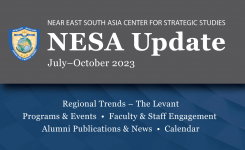- Near East South Asia Center for Strategic Studies
- Faculty Publication: "Jordanian stamps of Islam...
Faculty Publication: "Jordanian stamps of Islamic holy sites in Jerusalem: 1967-1989" by Michael Sharnoff

On 24 August 2023, the British Journal of Middle Eastern Studies published NESA Center Associate Professor Michael Sharnoff's research article "Jordanian stamps of Islamic holy sites in Jerusalem: 1967-1989."
ABSTRACT:
Jordanian postage stamp depictions of the Islamic holy sites in Jerusalem demonstrate how the Hashemite regime aims to bolster its legitimacy, balance relations with the PLO and Israel, affirm domestic and international sympathy and support to administer the Muslim holy places, and convey the kingdom’s close attachment to the Palestinian issue. These depictions aim to create the additional impression that due to Jordan’s special role, it has a strong stake in the stability west of the River and should be consulted in any political settlement between Israelis and Palestinians. Jordanian stamp depictions of the Islamic holy sites in Jerusalem are distinguished from other countries due to the Hashemite guardianship claim since 1924, Jordan’s annexation of Eastern Jerusalem and the West Bank in 1950, and Jordan’s interpretation of UN Resolution 242 that described these lands as Jordanian and should be returned under Hashemite sovereignty. This study aims to chronicle and analyse Jordanian stamp depictions from 1967 to 1989, one year after King Hussein’s decision to disengagement legal and administrative ties to the West Bank.
About the Author

Michael Sharnoff is an Associate Professor at the NESA Center. His areas of expertise include the history and politics of Egypt and the Levant, the Arab-Israeli conflict, and radical Islamist movements.
About the Publisher
The British Journal of Middle Eastern Studies is a peer-reviewed academic journal that publishes research on all aspects of the Middle East from the end of classical antiquity to the present day, including literature, politics, religion and cultures of the region.
The views presented in this article are those of the speaker or author and do not necessarily represent the views of DoD or its components.


